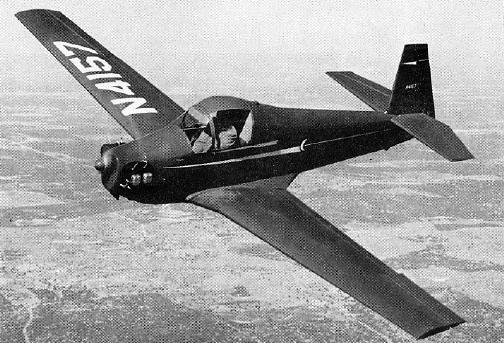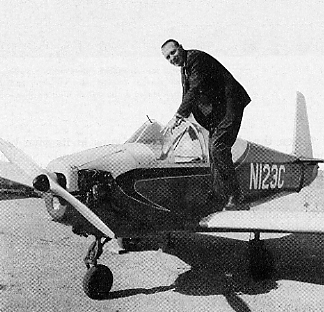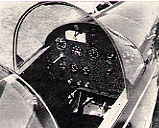
Used Aircraft Pilot Report: Mooney Mite
USED AIRCRAFT PILOT REPORT
 |
| With a powerplant of only 65 hp, the airplane scats along at about 125 mph in cruise. First models of the wood-and-metal aircraft were built in 1948. |
MOONEY MITE
A tight fit for pilots size 44 and over, but still plenty stylish if you're looking for the ultimate in personal transportation.
By CHUCK WOLFE
THEY LAUGHED when I said I was going to check-fly the Mooney Mite. I stand better than six-feet-four, and the scales usually quit shuddering somewhere on the leeward side of 230 pounds. The empty weight of a Mooney Mite is 500 pounds, and it looks like a Texan's idea of a model airplane. Obviously the editor had a point when he said, "Chuck, it: would be a good story if you could get into a Mite."
Faced with such a formidable challenge I set out to round up a Mite to check-fly. To the rescue came an aircraft dealer in Plainview, Texas -- Claude Hutcherson. Claude had acquired a 1948 model on a trade-in.
I'll be the first to admit that the approaching session with the Mite was viewed with apprehension. After all, in the 21 feet between the two square tips there is just 95 square feet of wing area. That could well mean a hot ship to handle.
 |
| The author, a Texan of heroic proportions, is a professional photographer as well as a pilot. His size 13 footware almost stymied the check flight. |
Looking down into the tiny cockpit, I thought my salvation had come. "I'll never squeeze into it," I announced with relief.
Claude answered by removing the seat and suggesting, "You can sit on the floor. If we trim your hair a little, perhaps you'll be able to close the canopy."
I did get in but was truthful in claiming it would be dangerous for me to fly it because just one of my size 13 shoes nearly covered both rudder pedals. "You should take off your shoes," tittered a bystander. The last chance of trading this assignment for one with the Petunia Growers Journal faded.
In a daze I realized the crowd had withdrawn a respectful distance with sadistic anticipation. The 65-hp Continental engine started easily after two strokes of the primer. Ground control's voice seemed bloodthirsty as I was cleared to taxi to the run-up area.
Alone, I closed the sliding canopy and reviewed the cockpit layout again. The panel included the basic instruments plus a turn-and-bank, directional gyro, two-way radio and a red flag on a five-inch stick. This red flag waves if the throttle is retarded while the gear is up. It is almost at eye level and brightly colored. Its frantic waggle should be a firm warning not to land gear-up -- evidently not firm enough, however, judging by the reported number of Mites which have made belly landings ( It is worth mentioning that usually a gear-up landing results in only a broken prop and some skinned under-panels ).
The throttle on this Mite was just below the bottom of the windshield on the left side. It was similar to the throttle on a J-3 Cub. Later models are equipped with the popular vernier throttle like that used on the Mooney Mark 20 series.
Removing the seat and taking off my shoes had left adequate room fore and aft, but the width was fixed and my stored calories flowed into position and then set like concrete.
 |
 |
| With a few added gauges, some Mites fly IFR. | Fuselage utilizes steel and wooden construction. |
The takeoff would have to be programmed like this: (1.) Hold the little short stick with right hand and advance throttle with the left. (2.) Change stick to left hand and reach down with right and re- tract the gear when the time comes. ( 3. ) Quickly reverse hands again and reach the trim crank on the left cockpit wall by twisting the left hand down with a kind of wilted backhand motion.
The dimensions were so crowded it was impossible to reach the trim by crossing over with the right hand. My left knee and the wall of the cockpit both contrived to get in the way.
Taxiing the Mite proved easy, with the nose wheel controlled through the rudder pedals. However, it is impossible to turn really sharply. Even with differential braking I nearly missed a cutoff on the taxiway. I fly a standard-sized Mooney quite frequently and guess I felt that if it turned sharply, this little version would turn very sharply. But this is just not the case.
Finally, there I was on the end of the runway ready to take off in a flying machine barely twice my weight. To reassure me, Claude had said, "Chuck, the Mite will be one of the easiest-handling planes you will ever fly." Naturally I didn't believe him. After all, he had so many hours he quit logging them when the total went over 16,000. My total time is a small percentage of his.
Oh well, the tower said go, and the runway was long and the sod on either side looked smooth and soft, and if I did run off, the plane could be repaired. By golly, it was going down the runway pretty straight, and you know it didn't seem like so hot a plane to handle after all. The airspeed said nearly 70 mph, and with just a little back pressure I was climbing and changing hands and reaching for the gear, and up it went. As near as I could figure, the rate of climb was nearly 1,200 fpm.
I realized that the plane hadn't gone into some wild uncontrollable maneuver when I switched hands on the various controls during takeoff. In fact it appeared that it would trim out nicely for hands-off flight. After leveling off at 6,500 feet, I flew level for a few minutes.
In spite of the cramped quarters, I was comfortable. With such nice hands-off characteristics, it did not seem like a bad cross-country airplane. There is a baggage area behind the seat that will hold 75 pounds ( 40 pounds in the Lycoming-powered version). Visibility is good. The only disconcerting thing is looking out at the small wings and trying to figure what keeps you in the air. The wing tips have a visible flex to them. This is normal, however. Mooney made it that way.
I checked the true airspeed on a computer and it worked out to 126 mph. I did not have time for a cross-country trip, but there is no doubt the plane is fast. In talking to other Mite pilots, I found they claim 125 to 135 mph; so the speed I got was within reason. Mooney ads on the Mite called for 130 mph at 10,000 feet with the Continental engine.
By now I was getting up nerve to try some stalls. Alright, the plane flew easily and steady in normal flight. I would find if my apprehensions were justified when I tried a stall. With cruise power I pulled the nose up to a ridiculous angle. Finally there came a hobble and the nose dropped. Quickly I eased back pressure and we were flying again. What happened? That was too gentle.
Let's try again, only hold it back and let it fall through. Again the hobble and the slight drop, and we were watching the nose oscillate at what seemed an average of 45 degrees. The airspeed read smack dab on 40 mph. Trying the same thing with power off, the stall would come at 45 mph. Never was there a tendency to spin or do anything other than break straight ahead.
Surely all the bad features would show up on landing. Holding the throttle all the way back, it still took a long time for the speed to fall below 95 so we could lower gear. Flaps can be dropped below 85 and are extended by a very novel method. As you lower the wheels, the trim of the Mite becomes nose-heavy. You roll the trim back, and at a certain point the flaps start down and everything remains in balance for hands-off descent at 75 mph. On the first landing I hit within inches of the pre-selected spot and rolled straight down the runway on the tricycle gear.
I made a number of landings and take-offs and did some flying around the area. It was the same as the first trip up. Landings were as simple as in anything I have flown. Takeoffs were easy, but called for some fast hand movements as mentioned.
The gear is operated manually with the single stroke of a lever. It is much like the system used on a Mark 21 except when the gear is down the handle is forward on the floor. A two-inch window between the rudders allows visual check of nose wheel position.
The Mite first went into production in 1948 at Wichita, Kansas, and 11 were built that year. In 1949 a total of 73 were produced. Assembly continued through early 1953 at Wichita, and by the time the factory was moved to Kerrville, Texas, 239 had been turned out. Production resumed in Texas in mid-1953, while Mooney was flying the experimental four-place Mark 20 (There is a marked resemblance between the Mark 20 and the Mite).
After a brief shutdown during a period of reorganization, production of the Mite was resumed while tooling up for production of the Mark 20. The main reason for continuing production was to hold the key trained men who would form the nucleus of the crew when the four-place Mooney started down the line. The company realized that the single-place plane was not the answer. When production was discontinued in 1955, the total was 355 Mites. There are still over 300 Miles flying today.
The new management at Mooney made some improvements in the 1955 model. The gear handle was relocated and made easier to operate. A bigger bubble canopy gave added room for a large person.
Construction of the Mite features an all-metal cabin section of welded chrome-moly steel tubing and aluminum skin covering. The rest of the plane -- wing, empennage, and aft fuselage is plywood with fabric covering for extra smoothness All control surfaces are welded steel-frame construction with fabric covering.
Fuel is carried in a main tank located behind the headrest and in an optional wing tank. Capacity of 12 gallons (16 gallons on 1955 model). The wing tank holds six gallons on either model. The gauge for the main tank is similar to the gauge on commercial-sized coffee urn -- it is a long glass tube behind the pilot's head.
 |
Currently, 1948 through 1954 Mites bring $1,200 to $2,000 or more, depending on equipment and condition. The 1955 version, with its improvements, usually sells for between $2,000 and $3,500.
Check-flying the Mite taught me not to believe all the old wives tales you hear about airplanes. Looks do not indicate flying characteristics.
What about the Mite now, eight years after production was stopped? Economy for sure. The small engine burns 3-1/2 to 4 gallons per hour of 80 octane. During this hour you cover better than 120 miles. This is good mileage in anybody's book.
I know of fully instrumented Mites that are flown IFR. If there is not a great need for baggage and no passengers, it is a good cross-country ship -- if you don't stand six-four and weigh over 230 pounds.
The Mite is certainly easy to fly. The Sunday-afternoon flier should be able to handle this plane safely. It seems to have no adverse flight characteristics. The sportiness of the Mite is unquestioned. One onlooker remarked, "I don't know how fast it is, but it looks fast."
Certainly, Mites will be patched and flown for many years. The Mooney factory is providing spare parts and repairs. There is not likely to be a drop in the popularity for this classic post-war design. After all, name a production aircraft that will go 120 or more miles on less than four gallons of gas.
[This article first appeared in the February 1964 issue of FLYING magazine, published by Ziff-Davis Publishing Company, New York. Our thanks to Denver Jacobson, C-GXTR, for providing it to us]
March 08, 2005